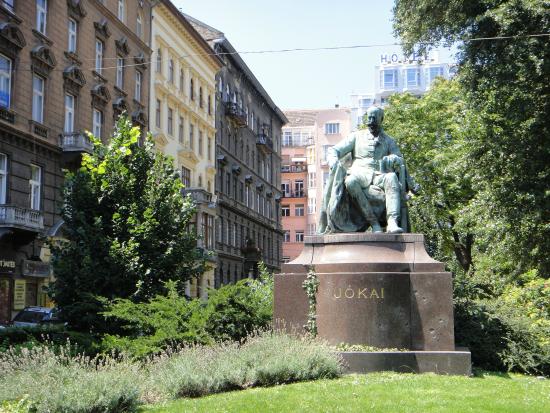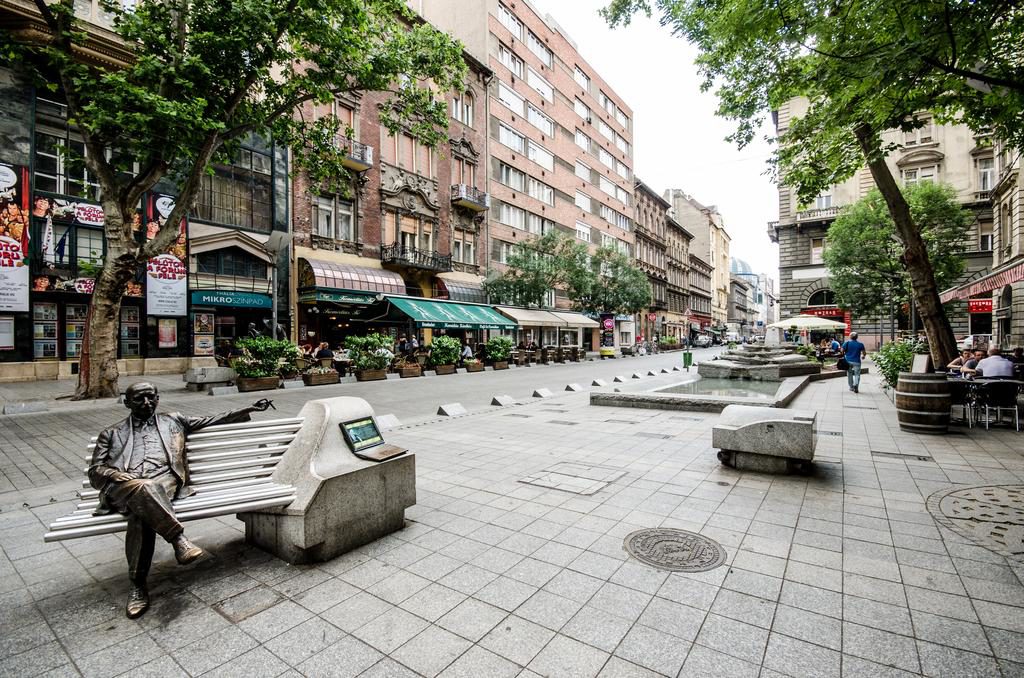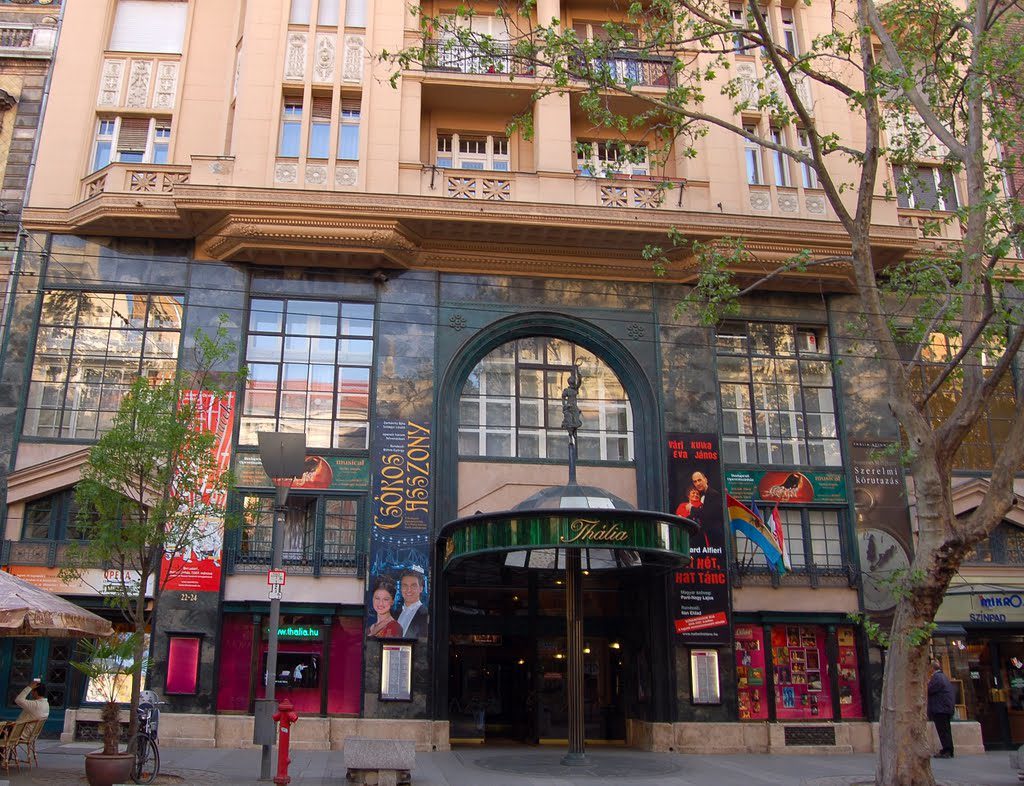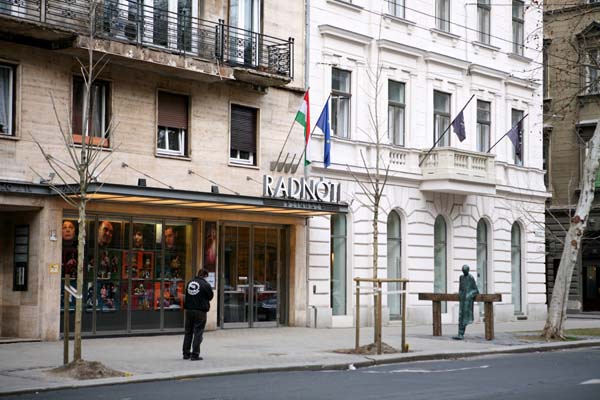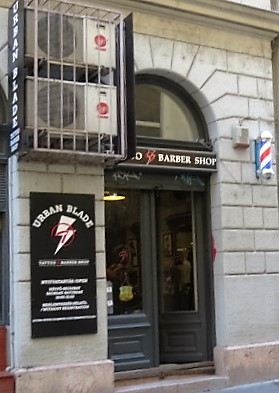A final stroll and possibly another Walk of Fame.
When we finished dinner, Pat was still undecided about the ultimate disposition of her final night. Would it be early to bed or an all-nighter? Or neither one nor the other but a bit of both. The restaurant needed the table so we paid our bill and began a leisurely walk back toward Andrássy Street. We crossed Andrássy and made a circuit of Jókai Square – which is really the extension of Liszt Square – but quieter and less commercial than its counterpart across the street. I assume the name changes because it’s a space that honors the writer and dramatist Mór Jókai who, comfortably seated, looks down at Andrássy Street from the head of the square.
When we finished our circuit, we turned to walk the two blocks toward the Opera House and in the direction of the hotel.
We’d only managed the first block when we reached Nagymező Street. Sometimes life can surprise you with what you’ve missed because you’re focused on moving from a starting point to a destination. When the goal is your focus, you might not be particularly attentive to what lies between the two points. This was certainly the case for me (and I assume for Pat) regarding Nagymező Street.
Sitting at my computer nearly four months after returning from Budapest I can count from memory at least six instances that Patricia and I had crossed the street together and noticed nothing out of the ordinary because we were, in each instance, going someplace. This night, however, as we ambled toward the hotel, something prompted one of us to turn right.
And when we did, we discovered a stretch of sidewalk where, at uneven intervals, we saw several of these embedded in the sidewalk:.
György Melis, I learned after I found this picture, was a Hungarian baritone who was a graduate of the Liszt Ferenc Academy of Music. Following his graduation in 1949, he was immediately given a place in the National Opera of Budapest. Born in Szarvas, Austro-Hungary in 1923, he died in Budapest in 2009 and I don’t know if this was placed on Nagymező Street posthumously or during his lifetime. Neither could I learn whether we’d accidentally stumbled on some equivalent of the Hungarian Walk of Fame because Melis’ was not the only set of footprints we saw.
As we continued down the street we came across this chap on the bench
with the nearby sculpted laptop showing some pertinent biographical data. (Look closely at this photo and you can see places where the paving stones have been replaced by markers similar to the one we saw of Melis.)
The seated fellow is Imre Kálmán. At birth he was Emmerich (the German equivalent to Imre) Koppstein and was born to a Jewish family in Siófok on the southern shore of Lake Balaton. Like Melis, he was a student at the National Hungarian Royal Academy of Music (later the Franz Liszt Academy) where he attended with Béla Bartok and one of Hungary’s other great and internationally famous 20th century composers Zoltán Kodaly.
Kálmán gained his greatest fame as a composer of operettas and, with Franz Lehár, led what has been called the “Silver Age” of Viennese operetta during the first quarter of the 20th century. Rather ironically, Kálmán, despite his Jewish heritage, was one of Hitler’s favorite composers and Hitler offered him the chance to become an ‘honorary Aryan’. Kálmán refused and was forced to move first to Paris, then to the United States before eventually returning to Europe where he died in Paris in 1953 at the age of 71.
The placement of Kálmán’s statue is no accident. Stand behind him, follow his gaze and you will see
the Budapest Operetta Theater which is more than 100 years old. But I’m not done with the charms of Nagymező Street. Opposite the Operetta Theater but on the same block is the Thália Színház or Thalia Theater. (The Thalia is a “presenting theater.” This means it has no troupes of its own but hosts guest performances and guest artists. Opened in 1913, the theater has had a dozen name changes.)
And, had we re-crossed Andrássy and walked half a block or so we’d have found the theater named in honor of Miklós Radnóti – a Hungarian Jewish poet who died in the Holocaust.
The statue with his hands in his pockets leaning on the bar is Radnóti. (According to We Love Budapest, the
Radnóti Theater is an interesting product of the capital’s theater scene: the titles on the repertoire, marked by the names of Chekhov, Gogol or Ibsen, do not necessarily suggest that “wild and modern”, progressive characteristic that gives the spice of Nagymező Street’s theater. Their primary goal is to strike a balance between various directions and classic traditions while keeping up a modern approach. Each year, the theater offers four premieres, and eight plays in its repertoire.)
In fact, as I came to learn while scouring the internet for some of these photos, Nagymező Street is called Budapest’s Broadway. Our hotel was barely more than two blocks away and, had we not taken the time to look on that last night, we would never have known.
A few final words.
I have very little left to tell you and if you’ve followed along for the entirety of this nearly 98,000-word opus, I wouldn’t blame you for thinking, “Thank goodness!” So, here are my final few concluding thoughts.
In the first entry of this year’s journal, I mentioned some of the technological gremlins that beset me on my journey. The fallout from one of them was the loss of my camera and, later, my inability to take photos of signs and places that I’ve found amusing – something I’ve done regularly on past trips.
Fortunately, Pat snapped one of a shop near our hotel in Budapest. We walked by this place often and it amused and baffled me every time.
If you can’t quite read this sign, I’ll have you read this description from We Love Budapest:
Urban Blade Tattoo & Barber Shop is a really special place where the trendy men-only barber shop culture meets with a tattoo saloon. The barber-shop area is only for men but of course there’s no rule that forbids a woman to step into this realm especially since the tattoos are for everyone. And if you need a haircut and a tattoo as well, you’ll get a discount.
The website led me to find that Budapest has several interestingly named salons including Cult Hair & Bazaar, Hair’s[ku:l] and (in my opinion) the brilliantly named Horror Barbie. But, although each has some sort of gimmick to attract customers, none have the audacity to combine a tattoo parlor and barber shop. One can only hope that no one enters for a haircut and leaves with a tattoo (unless they want the discount!).
The four women were long gone by the time I trundled down to the hotel lobby at 06:20 or so to await my 06:30 pickup. However, the appointed time passed and no car arrived. When the wonderful staff saw me still waiting at 06:45 they took the initiative to first call Barbara (I guess she is the only tour guide in Budapest named Barbara) who told them to call a taxi for me and pay for it with hotel funds. I reached the airport in plenty of time to comfortably pass through security and make my flight. Once I settled in at home, I made certain to email the hotel manager to commend the staff.
The flight home was uneventful and although there was some confusion with the Super Shuttle at Dulles, I arrived home with enough time that had I hurried, I could have gotten to Maryland’s campus in time to see all or most of the volleyball team’s Saturday night match. But my body clock was six hours ahead – meaning it felt as though it was sometime between midnight and 1:00 and adding another two hours with driving involved simply didn’t seem prudent. But the deeper truth is, having been gone for three weeks, I simply didn’t have the heart to make a brief appearance, drop off my bag and then immediately leave my cat, Zicomo, alone again.
Seriously, could you?
